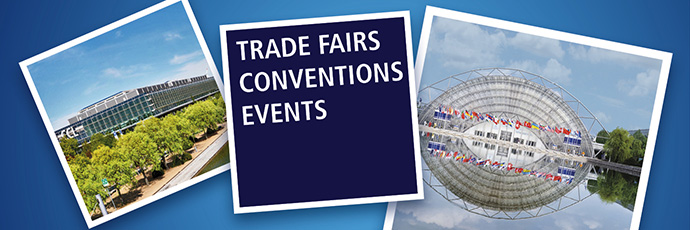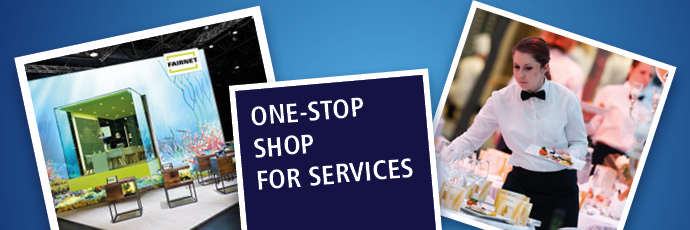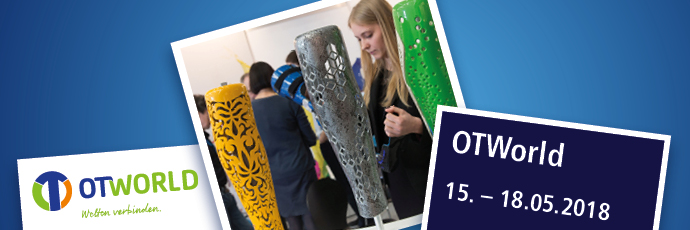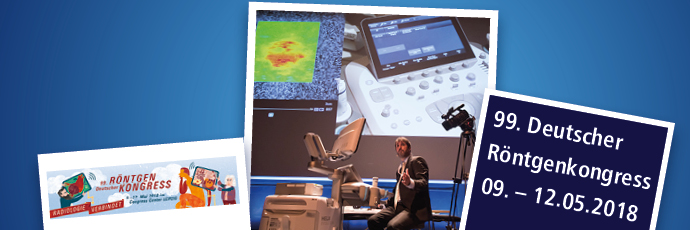
Kunst in der Leipziger Messe: The modern world in lights and colours
Artists from all over the world have participated in the design of the new Leipziger Messe. As early as the building phase, they were invited to select suitable locations for their works on the premises. It also means that the city gained another artistic site with the new exhibition grounds that were opened in 1996.
The following works can be viewed on the Leipziger exhibition grounds:
Angela Bulloch: Belisha Beacon Indicator System (connection tubes between Glass Hall and East entrance hall, and to Halls 4 and 5)
Daniel Buren: Das Auf und Ab der Farbe (escalators, Glass Hall and Congress Center Leipzig)
Stanislaw Drózdz: odtad - dotad (Where to - Where from; foyer Trade Fair Hall 1)
Peter Fischli, David Weiss: Landschaft (final stop Line 16)
Günther Förg: Wandmalerei (atrium of the trade fair building)
Isa Genzken: Rose (Glass Hall, West entrance)
Dan Graham: Messe Leipzig Structure (Pocketpark)
Jenny Holzer: Truisms (trade fair cashiers, West entrance, Glass Hall)
Martin Kippenberger: Metro Net (Messepark)
Sol LeWitt: Wall drawing # 516 (Congress Center Leipzig)
Thomas Locher: Angebot und Nachfrage (atrium of trade fair building)
Olaf Nicolai: Pflanze / Konstrukt (Glass Hall)
Hanno Otten: Farbenlehre (Congress Center Leipzig)
Jorge Pardo: Gestaltung der International Business Lounge (Glass Hall)
Rirkrit Tiravanija: Flipper Wall for Palermo (Messepark)
Niele Toroni: Pinselabdrücke Nr. 50 in regelmäßigen Abständen von 30 cm (Messeclub at Trade Fair House and Congress Center Leipzig)
Angela Bulloch (1966)
Belisha Beacon Indicator System
Lamp installation, connection tubes between Glass Hall and East entrance hall, and to Halls 4 and 5
Angela Bulloch is concerned with the organisation and rules that apply to the way humans live together. She uses "Belisha beacons" for her light installations - light signals that mark pedestrian crossings in England. To this end, she adopts an element from road traffic, a ubiquitous system of rules and regulations. As part of her work in Leipzig, motion sensors have been added to these light signals. The movement flows produced by the trade fair visitors thus become a part of the installation: Each person is involved in this process by triggering a light reaction - thus passers-by become a part of an organisation which they themselves can influence.
Daniel Buren, (1938)
Das Auf und Ab der Farbe (The Up and Down of Colour)
Escalators, Glass Hall and Congress Center Leipzig
Daniel Buren works with vertical lines that are 8.7 cm wide, which he uses to "draw" a location. He does not draw a line between location and work, since work is always completed within and in reference to a space. He describes this interplay of lines and location as work "in situ". His decision in favour of the lines was made in 1968 as a radical rejection of traditional painting and the definition regarding the autonomy of a work of art. Often, his markings represent small interventions into the adjoining space - as is the case in Leipzig. In Leipzig, Buren applied red and white lines to 31 of approximately 70 steps on each escalator. The markings are minimal in relation to the dimensions of the large Glass Hall, the Congress Center Leipzig and the East entrance hall. But they nevertheless catch the visitor's eye through movement - namely the appearance and disappearance of the colours. Hence the escalators designed by Buren create a connection between the various locations.
Stanislaw Drózdz (1939 - 2009)
odtad - dotad (Whereto - Wherefrom)
Text works, Trade Fair Hall 1 Foyer
Short texts or words form the starting point of works by Stanislaw Drózdz. They become images once their semantic meaning is initially destroyed, for example through their configuration in the room, in order to be re-created. Drózdz' text piece for Leipziger Messe extends over 80 metres in length. The Polish words "odtat" and "dotad" are painted on the white walls in black colour. The configuration is not strictly regimented, and presents a relaxed sequence on the foyer wall.
Peter Fischli (1952) und David Weiss (1946 - 2012)
Landscape
Concrete works, final stop Line 16
Since their initial joint work projects in 1979, Peter Fischli and David Weiss have focused on the concepts of scale and perception, rules, standards and hierarchies. Their concrete art work, which measures 210 x 320 centimetres and was created for the Leipziger exhibition grounds, appears as a product of coincidence, like construction waste eaten away by erosion, or - as expressed by Peter Fischli - the location for a "puddle". But once viewers adjust their perspective, hence change their viewpoint to include details and let their imagination roam, their view may change considerably: grooves become valleys, extensions become mountain ridges, and the puddle becomes a lake. Moss starts to grow, small animals take over the new ecosystem and weathering creates it own microcosm.
Günther Förg (1952)
Murals
Atrium of the trade fair building
Günther Förg works with a variety of media: photography, painting, sculptures, drawings, murals, which he often combines into complex room installations. His works focus on architecture and its structures. This discussion usually takes place in the form of series, in which he circles rather than conclusively completes a theme. His site-specific murals consist of monochrome colour areas, which relate to the dimensions of the respective room and are designed to create a dialogue with the surrounding environment. In the work done for Leipziger Messe, the wall is divided into half. Four colours are applied on eight fields. Individual brush strokes create a paint quality that forms orientation points in architecture and turns it into an unmistakable location.
Isa Genzken (1948)
Rose
Glass Hall, West entrance
"A rose is a rose is a rose." This often-cited quote by American author Gertrude Stein refers to the many meanings a rose may take on as a symbol for love, pain and the passage of time. Seen up close, the oversized metal rose by Isa Genzken unfolds a naturalistic-sculptural character and appears colossal, almost threatening. A metal colour stem under the blood-red flower irritates with its artificiality. With its position in the middle of the symmetrically staged perspective of the glass and steel architecture, it forms a counterpoint as a bright dot of colour, and at the same time acts as a caricature of the monumental nature of the Glass Hall on account of its colossal size.
Dan Graham (1942)
Messe Leipzig Structure
Glass Pavilion, Pocketpark
One defining theme in Dan Graham's works is the interplay of societal and architectural influences. He has been designing pavilions made of one-way mirror glass for special locations since the 1970s. They absorb and reflect the form repertoire of urban architecture, and which are based on simple geometric forms such as circles, ovals, rectangles and triangles. Since one-way mirror glass is similarly reflective and transparent on the inside as well as outside, an observer can see himself and also others who are observing him and themselves. Added to these effects are changing impressions resulting from changing weather conditions, different light incidences and angles of vision. The one-way mirror pavilion in the open space between the West and East hall opens the view to its interior or closes itself off from outside view depending on light conditions. Graham views his pavilions as aesthetic objects as well as locations for social contacts, which only fulfil their purpose once they are used and experienced by the observer.
Jenny Holzer (1950)
Truisms
Electronic inscribed tablets, trade fair cashiers in West entrance, Glass Hall)
"Language is the simplest form, while images distract." For many years, language has been Jenny Holzer's artistic medium. Her early works - anonymous texts on placards, stickers, signs or electronic banners - could be seen all over New York, with an intentional distance to art businesses and the art market. Now she also works for art institutions, even though her themes have remained the same: power, the effects of politics on individuals, violence and death. Her messages are kept colloquial without any pathos, or are composed using political jargon. The text series "Truisms" was created between 1977 and 1979, and is comprised of more than 300 alphabetically sorted statements. In them, she combines aphorisms, clichés and stereotypes such as "protect me from what I want", "money creates taste" or "torture is barbaric" in a style that is short, memorable and sometimes contradictory. In the entrance of the West glass hall, two electronic banners have been installed on the back wall of the two cashier areas, featuring a selection of statements chosen by Jenny Holzer for Leipzig.
Martin Kippenberger (1953 - 1997)
Metro Net
Subway station for an imaginary global subway network, Messepark
Playing with fiction and reality - the realisation of absurdities and profound questioning of what is real - characterises the works of Martin Kippenberger. The subway station on the grounds of Leipziger Messe is neither closed nor really in operation. It forms a part of an imaginary subway system designed by the artists on a global level as part of the "Metro Net" project. Other such entrances, which end underground and do not go anywhere, exist in Dawson City (Canada) and on the island of Syros (Greece). Ventilation shafts, which also form a part of this subway system, can be found in Tokyo and St. Georgen in the Black Forest. "Metro Net" is directed to those that journey with their thoughts - to think about it means to be on your way.
Sol LeWitt (1928 - 2007)
Wall drawing # 516
Mural, Congress Center Leipzig
Starting in the 1960s, Sol LeWitt reduced his design language to stereometric basic forms, using the basic colours red, yellow, blue and also black. Using these simple tools, he designs serial shelving systems with calculated deviations - whereby the differences between the various components form the theme of the composition. The work that can be found on the outside walls of the congress halls of the Congress Center Leipzig is among the wall drawings that assume an important place in the work of this artist, in addition to sculptures. Arranged in quadratic fields that are placed beside each other, it presents a pyramid-like basic form (flat top pyramid), into which three layers of the basic colour have been applied in the individual fields of the form. The repetition of the same motif is accompanied by a wide variation in colours. The serial painting style - a key principle of minimalistic art, for which Sol LeWitt is the main representative - propagates a turn away from unique art works and does away with hierarchies. What matters is the thought process, not the implementation, which he therefore leaves to others.
Thomas Locher (1956)
Angebot und Nachfrage (Supply and Demand)
Text work, atrium of the trade fair building
Thomas Locker investigates language as a system of rules for human relationships. His texts, which consist of short sentences and follow grammatical rules 'to the letter', appear to mean nothing beyond the statement itself - statements that are highlighted and analysed through the installation. Locher's Leipzig work broaches the issue of the main principles behind action, and relates to the self-image of the trade fair as a trading place of goods and merchandise. His text is divided into five blocks. Statements set in sequence, in black film letters on glass, describe situations between giving and receiving, desire and rejection in different variations - serious and ironic, real and absurd at the same time. A dialogue takes place between the imaginary "I" and another person.
Olaf Nicolai (1962)
Pflanze / Konstrukt (Plant / Construct)
Terazzo floor works, Glass Hall
Olaf Nicolai looks at ordering principles, such as collecting, as a form of preservation and passing-down, or garden landscapes (hortus) as places of knowledge and the cultivation of physis (plant) as meta-physis (order). He points to the 19th century, when the separation between the sciences and art was not as strict as it is now. A way of thinking which is gaining favour again in the context of the linkages between various areas and forms of insights. His work on the Leipziger exhibition grounds broaches the issue of nature as a construct. It is based on a silhouette that shows a stylised twine. On the centre axis of the Glass Hall, it becomes a surface ornament that is integrated into the floor as a terazzo work. In this way, Nicolai also relates to the surrounding architecture, and picks up on its allusion to earlier glass palaces and greenhouses in England.
Hanno Otten (1954)
Farbenlehre (the study of colour)
Colour work, Congress Center Leipzig
Hanno Otten looks at the phenomenon of colour in an artistic and scientific dimension. He is interested in models and theories that have categorised colours by carious criteria since Newton and Goethe, and also in the current meaning and relationship between colours in the science areas and daily life. His serially arranged seven quadratic tables in the Congress Center Leipzig represent the contemporary stock-taking of colours. It was filtered from light using photo-technical methods, and visualised on light-sensitive Ilfochrome. The technique that is applied establishes a reference to the creation of colour in electronic media, which increasingly determine the colours of our living environments. The work also broaches the issue of the interlocking of technical-objective and subjective colour compositions. It highlights the fact that colours of modern image media in their dissonant combinations and bright contrasts are picked up by fashion and transported into daily life. The consciousness of colour and associated understanding of harmony will depend on time and will change.
Jorge Pardo (1963)
Design of the International Business Lounge (Glass Hall)
Glass Hall
Jorge Pardo expands the definition of art by doing away with the line between applied and liberal arts, and by integrating architecture and design into his work. When he designs or modifies everyday items, he is interested in function, form and colour as the design basis of our environment. He also takes a critical look at modernity with allusions or quotes. With regard to his objects, what matters primarily is their relationship to each other, as well as the situation that they create for the observer or user. The furnishings of the International Business Lounge in the Glass Hall were made according to his designs, and the walls were painted in alignment with the same.
Rirkrit Tiravanija, (1961)
Flipper Wall for Palermo
Ensemble of 1.40 metre high walls painted in oxen blood red, Messepark
Rirkrit Tiravanija's "Flipper Wall for Palermo" is remindful of his art colleague Blinky Palermo (1943 to 1977), who was born in Leipzig. He re-created a famous work by Palermo at a scale of 1:2. In 1973, Palermo painted the partition walls of the Hamburg Kunstverein in oxen blood red, and declared the art location itself as art. Tiravanija views the art space as a social and cultural space. His contributions to exhibitions in galleries and museums often consist of invitations to meals in the art space, in which he cooks for guests, or of arrangements of furniture and everyday items that visitors can use to start conversations. In Leipzig, he has created a type of monument to Blinky Palermo, and also a place of communication and experience. Tiravanija wants his work to be used - by children or school classes that can use his walls as play objects. According to the motto: "Something only comes alive once it is touched and used."
Niele Toroni (1937)
Pinselabdrücke Nr. 50 in regelmäßigen Abständen von 30 cm (Brush impressions No. 50 at regular 30 cm intervals)
Murals, Messeclub Messehaus and Congress Center Leipzig
Towards the end of the 1960s, Niele Toroni and his art colleagues - including Daniel Buren - revolted against "salon painting" and its claim to representation. He reduced his work to a painter's gesture that is repeated - avoiding any content and hierarchy. Each impression of the brush stands for itself and nothing else. The homogenous prints create a picture in line with a calculated decision. Toroni usually uses basic colours, and more rarely mixtures such as orange or green. A new aspect of each work is the relationship between impression, base surface and architecture.
- HTML





